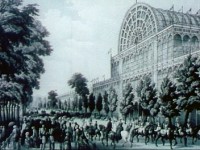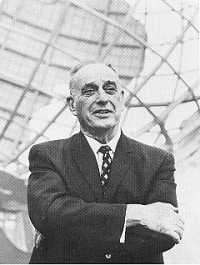The basic purpose of the Fair
is to help achieve 'Peace Through Understanding,' that is, to
assist in educating the peoples of the world as to the interdependence
of nations and the need for universal and lasting peace.
-Invitation of Foreign Nations
to the New York World's Fair 1964-19651
What aspirations. This was not just the
building of a park. This was not just convenient product placement.
This was not just fun. This Fair took on meaning much greater
than could be weighed in tons of steel and counted in sales of
tickets. This was destined to be an "Olympics of Progress,"
a playground on which the bullies played on the same team as
the skinny nerds, and everybody won. The New York World's Fair
of 1964-1965 was going to bring the world together, bridge cultural
gaps and celebrate "man's achievements on a shrinking globe
in an expanding universe."2
The Fair Corporation was a private non-profit company independent
of the United States government, but in true American fashion
it absorbed contemporary American ideals and imposed them upon
participants and visitors alike. Ideals, however, could only
take the Fair so far in an age of Cold War marked by nuclear
threats, social uprisings and third-world suffering. What resulted
in 1964 and 1965 was a fantasyland in which cooperation and brotherhood
were smudged with the thumbprint of Cold War politics, the very
circumstance that prompted the idealism of the Fair and created
the need for such an event in the first place.
Visions of peace and progress have been
part of world's fairs since the popularization
of modern fairs in 1851. Kenneth Luckhurst, in The Story of
Exhibitions, chronicles the rise of fairs from their roots
as trade markets of the Middle Ages in which the exchange between
exhibitor and visitor created long-lasting effects.3 Britain was the first nation to change the
formula and hold an industrial exhibition, with France soon to
follow. The two nations used exhibitions initially as a tool
in their political rivalry during the eighteenth century. Both
nations' exhibitions boasted of their respective achievements
in the world spotlight. By the mid-nineteenth century, the scope
of these exhibitions expanded. They "assumed an international
character" and were "the means of ushering in an established
and universal peace."4
It was about this time that the modern
state system was fully established in the Western world, and
exhibitions became important within this context. Nations worked
to create an individual image of military, commercial and cultural
strength in a competitive system. London's Crystal Palace of
1851 brought the emergent form of cultural competition to the
world stage-the world's fair.
London's Crystal Palace of 1851*
 |
The United States was quick to follow London
with its own fair. The New York Crystal Palace of 1853 established
the non-governmental approach to fair planning in the United
States. The government only specified the building materials
and the admission price. President Franklin Pierce, however,
expressed his hope that the Fair would be useful in unifying
the nation in a time of divisiveness. Instead, the Fair lost
hundreds of thousands of dollars and was a pronounced failure.
Five years later, the Crystal Palace burned to the ground, along
with the motivation to bring the nation together with a fair
for years to come.5
Fairs in the United States after the Civil
War had a largely international focus, with
America's role in the world at the heart of them. According to
Robert W. Rydell in All the World's a Fair, the American
fairs of the Victorian Era dealt with the imperialistic urges
of the reunited nation. The fairs in this time period were planned
by city elites. They exhibited progress by emphasizing racial
hierarchies alongside man's elevation from savagery to civilization.
Chicago's World's Columbian Exposition of 1893, for example,
commemorated the 400th anniversary of Columbus's landing in the
Western Hemisphere. Notions of discovery and expansion as inherently
American ideals pervaded this Fair, uniting middle class citizens
behind white supremacist and imperialist ambitions. Such ideologies
helped relieve the concerns of visitors about the problems and
hard times that lay beyond the gates of the Fair. From this point
forward, fairs in America had the purpose of easing the tensions
of the world in the minds of visitors.6
After the devastation of World War I and
the Depression, fairs in the United States
once again acted as tools for domestic reconstruction. Known
as the Century-of-Progress exhibitions, these fairs were useful
in restoring "popular faith in national progress."
These fairs focused significant attention on the ways of modernizing
American society in order to cope with the future.7
Fairs both in the United States and abroad
became more international in spirit following World War II. They
emphasized the idea of a common humanity, while subtly advancing
a domain of corporate exploits and globalization.8 Hence the New York World's Fair 1964-1965,
an exposition overwhelmingly dominated by commercial exhibits,
was given the theme of Peace Through Understanding. The
competitive international system of the 1960s, which was powerfully
shaped by the Cold War between the US and the USSR, was the context
in which the 1964 Fair acquired its ideals.
The anthropologist Burton Benedict, discussing
the symbolic nature of fairs, argues
that rituals such as these are a "stabilizing force acting
to keep society in equilibrium."9 Such rituals include the universal human
tendency toward competition--an "Olympics of Progress"
for instance. Benedict discusses how "fairs take people
out of their ordinary routines and thus remove them temporarily
from their usual positions in the social structure."10 In order for nations to be able to trade
and act in such environments, "traditional enemies must
lay aside the inclination to fight."11
As a site of healthy competition amongst
nations, a site of romantic escape from international turmoil,
and a site where arms were laid down and negotiations could take
place between adversaries, it was anticipated that the 1964 Fair
would be useful in the same ways as American fairs past. It could
bring a divided nation together behind the ideals of democracy
in contrast to pavilions of nations with alternative systems.
It could exchange culture, art and ideas with competitors and
cultivate new friendships from around the globe. It could enhance
America's influence in and on the world. But the vision of the
Fair was even more ambitious. Peace Through Understanding
could actually save the world.
"An exhibition will simply foster
whatever spirit pervades the people concerned with
it," wrote Luckhurst.12
In the case of the 1964 Fair, the concerns of the organizers
went beyond the walls of the administrative offices of the Fair
Corporation. The Fair met the concerns of three presidential
administrations, the Department of State and Bureau International
des Expositions, the new nations of Africa, the Communist nations
of the Europe and Asia, the warring nations of the Middle East
and one very opinionated public servant in the role of Fair President.
The abundance of concerns made it difficult for the International
Affairs and Exhibits (IAE) department of the Fair to accomplish
its grand dreams.
1964/1965 New York World's Fair President Robert
Moses*
 |
The 1964 Fair Corporation intended to keep
the Fair as apolitical and nongovernmental as possible. During
the earliest planning stages in 1959, the directors made a policy
decision banning patronage of political cronies or business contacts.
When Robert Moses came on board as Fair President, he repeatedly
wrestled the Fair out from under the influence of city and state
politicians (although he did not always abide by the ban against
business patronage). "Moses' distaste for kowtowing to anybody"
and "an unerring knack of rubbing Congressmen the wrong
way" are just a few in a long list of reasons why Moses
was glad to keep the Fair away from politics.13 He was not entirely successful, though.
The members of the IAE constantly had to
work within the confines of protocol, deal
with unstable governments and political uprisings, and dodge
international crises in order to go about their business of arranging
a world's fair that actually featured the nations of the world,
all without the backing of an army or a powerful bureaucracy
such as the State Department. The IAE had many failures, and
gaping holes were left in the International Area by prominent
nations. "A fair is not, after all, a government,"
wrote the New Yorker. Acting as "part diplomat and part
salesman," the members of the IAE faced conditions that
provided all the more prerogative for such a daring aspiration
as Peace Through Understanding.14
In his New York Times opening day essay,
"Why a Fair? And Why This Fair?" Moses wrote, "What
distinguishes a world's exposition from a local fair obviously
must be its universality and its inquiry into the common destiny
of mankind. All the talents are engaged in a fair; the hope is
that if they can together build a big show, they can eventually
build a viable world."15
Such a statement speaks to the post-World War II search for a
connection between American destiny and worldwide peace, and
to the importance of the exchanges of cultures and abilities
during the Cold War.
© Copyright 2005 Sharyn Elise Jackson, All Rights
Reserved.
|